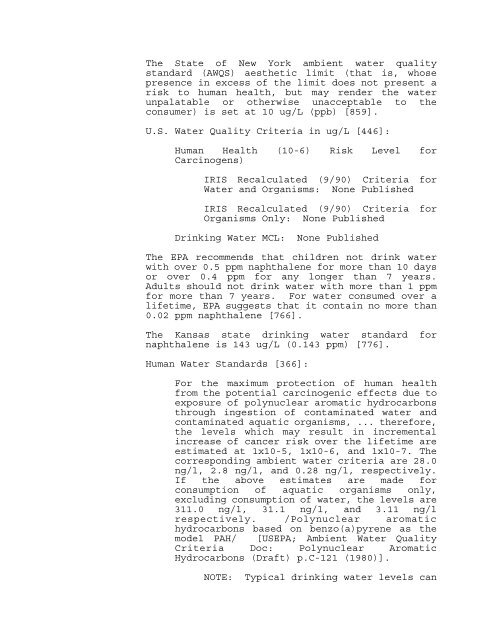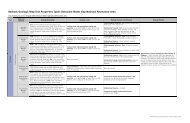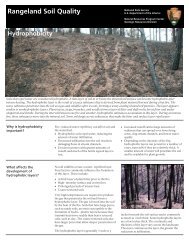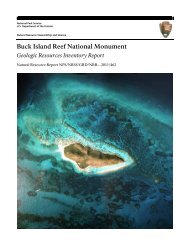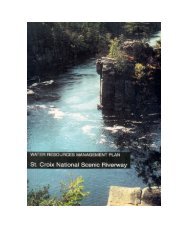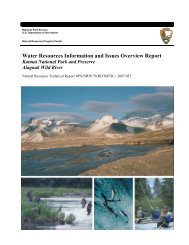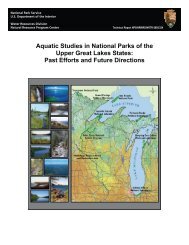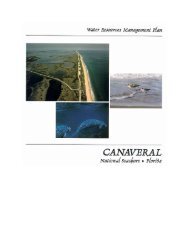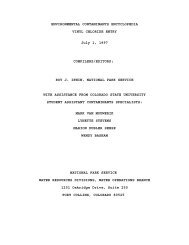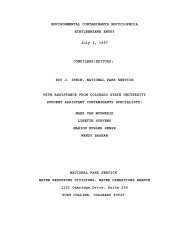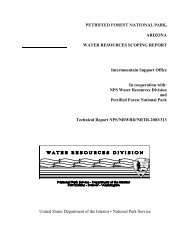ENVIRONMENTAL CONTAMINANTS ENCYCLOPEDIA ...
ENVIRONMENTAL CONTAMINANTS ENCYCLOPEDIA ...
ENVIRONMENTAL CONTAMINANTS ENCYCLOPEDIA ...
You also want an ePaper? Increase the reach of your titles
YUMPU automatically turns print PDFs into web optimized ePapers that Google loves.
The State of New York ambient water quality<br />
standard (AWQS) aesthetic limit (that is, whose<br />
presence in excess of the limit does not present a<br />
risk to human health, but may render the water<br />
unpalatable or otherwise unacceptable to the<br />
consumer) is set at 10 ug/L (ppb) [859].<br />
U.S. Water Quality Criteria in ug/L [446]:<br />
Human Health (10-6) Risk Level for<br />
Carcinogens)<br />
IRIS Recalculated (9/90) Criteria for<br />
Water and Organisms: None Published<br />
IRIS Recalculated (9/90) Criteria for<br />
Organisms Only: None Published<br />
Drinking Water MCL: None Published<br />
The EPA recommends that children not drink water<br />
with over 0.5 ppm naphthalene for more than 10 days<br />
or over 0.4 ppm for any longer than 7 years.<br />
Adults should not drink water with more than 1 ppm<br />
for more than 7 years. For water consumed over a<br />
lifetime, EPA suggests that it contain no more than<br />
0.02 ppm naphthalene [766].<br />
The Kansas state drinking water standard for<br />
naphthalene is 143 ug/L (0.143 ppm) [776].<br />
Human Water Standards [366]:<br />
For the maximum protection of human health<br />
from the potential carcinogenic effects due to<br />
exposure of polynuclear aromatic hydrocarbons<br />
through ingestion of contaminated water and<br />
contaminated aquatic organisms, ... therefore,<br />
the levels which may result in incremental<br />
increase of cancer risk over the lifetime are<br />
estimated at 1x10-5, 1x10-6, and 1x10-7. The<br />
corresponding ambient water criteria are 28.0<br />
ng/l, 2.8 ng/l, and 0.28 ng/l, respectively.<br />
If the above estimates are made for<br />
consumption of aquatic organisms only,<br />
excluding consumption of water, the levels are<br />
311.0 ng/l, 31.1 ng/l, and 3.11 ng/l<br />
respectively. /Polynuclear aromatic<br />
hydrocarbons based on benzo(a)pyrene as the<br />
model PAH/ [USEPA; Ambient Water Quality<br />
Criteria Doc: Polynuclear Aromatic<br />
Hydrocarbons (Draft) p.C-121 (1980)].<br />
NOTE: Typical drinking water levels can


